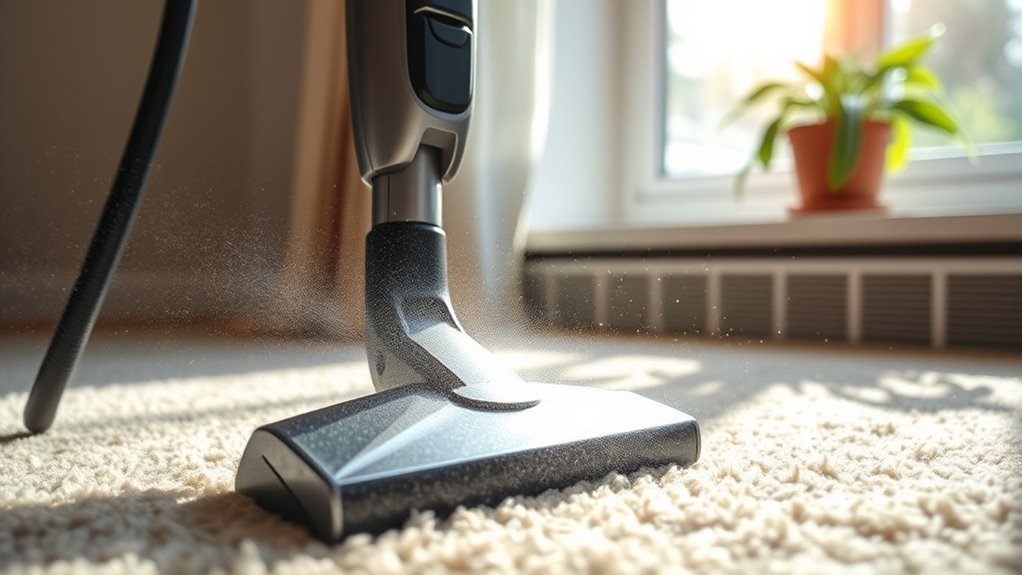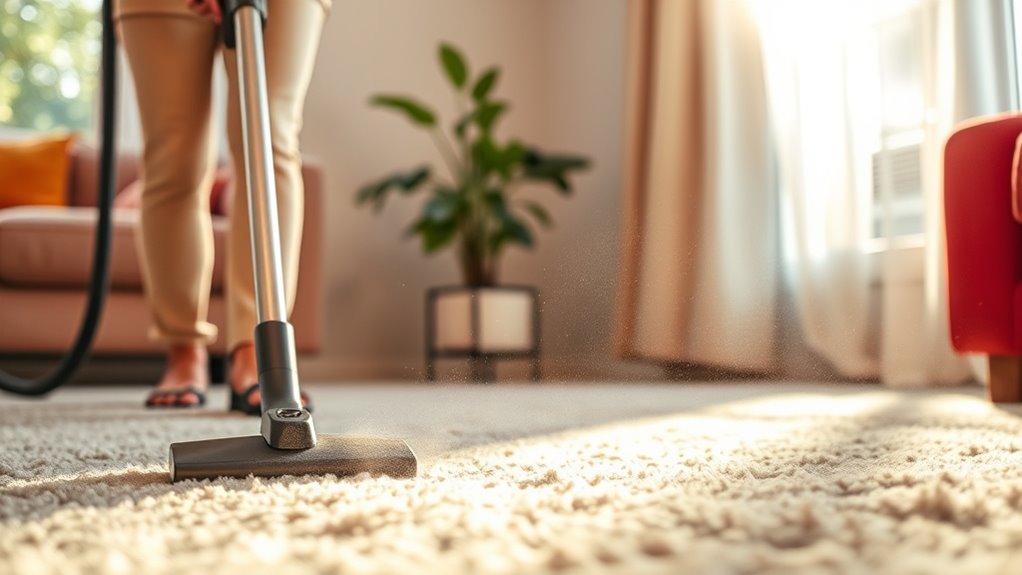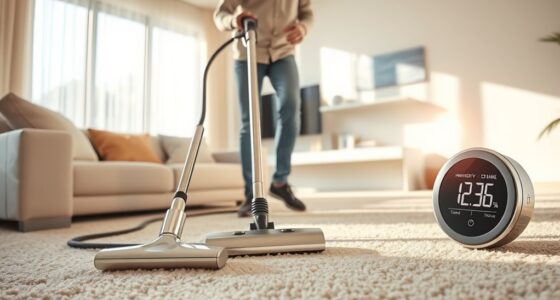Vacuuming is essential for asthma management as it helps reduce allergens like dust, pet dander, and mold spores in your home. Regular vacuuming—especially with a HEPA filter—ensures that these particles are trapped rather than redistributed in the air, creating a healthier environment for you. Aim to vacuum once or twice a week, increasing frequency if you have pets. A proper cleaning routine not only lowers allergens but also enhances your asthma control. There’s more to evaluate for ideal results.
Key Takeaways
- Regular vacuuming reduces allergens like dust and pet dander, significantly improving asthma control and indoor air quality.
- Using HEPA filters in vacuums effectively traps small particles, preventing allergens from being redistributed into the air.
- Vacuuming once or twice a week helps maintain a low allergen environment, especially in high-traffic areas.
- Complement vacuuming with washing bedding and keeping the home clutter-free to further reduce allergen buildup.
- Regular vacuum maintenance, including emptying canisters and cleaning filters, enhances performance and maximizes allergen removal.

Regular vacuuming can considerably impact asthma management, making your home a healthier place to breathe. You might not realize how much dust, pet dander, and other allergens accumulate in your home, but these can trigger asthma attacks and worsen your breathing. By incorporating a consistent vacuuming routine, you can substantially reduce these allergens, helping you and your family breathe easier.
Regular vacuuming significantly enhances asthma management by reducing allergens, creating a healthier breathing environment for your family.
When you vacuum, consider using a vacuum cleaner equipped with HEPA filters. These filters are designed to trap small particles that standard vacuums might miss, ensuring that the air quality in your home improves. With HEPA filters, you can capture allergens like pollen, mold spores, and dust mites effectively. This means that while you’re cleaning your floors, you’re also actively working to reduce allergens in the air you breathe. Switching to a vacuum with a HEPA filter is a simple yet effective step toward better asthma management.
It’s vital to vacuum regularly, ideally once or twice a week, depending on your household’s needs. If you have pets, you might want to increase the frequency to combat pet hair and dander effectively. You should also pay special attention to high-traffic areas where dust tends to accumulate. By being proactive in your cleaning routine, you can ensure that allergens don’t have a chance to settle and become airborne again.
In addition to vacuuming, consider other aspects of your cleaning routine that contribute to allergy reduction. Wash bedding and curtains regularly, as these can harbor dust mites and other allergens. Keeping your home clutter-free also helps reduce places where dust can accumulate. By combining these practices with regular vacuuming, you’re taking an extensive approach to asthma management.
Lastly, don’t forget to maintain your vacuum cleaner itself. Regularly empty the canister or replace bags to ensure it operates at peak efficiency. Cleaning the HEPA filter as recommended by the manufacturer is equally important. A well-maintained vacuum will perform better and keep your indoor air cleaner. Moreover, using a vacuum with HEPA filters can be particularly beneficial in trapping allergens that exacerbate asthma symptoms.
Frequently Asked Questions
How Often Should I Vacuum to Manage Asthma Symptoms Effectively?
You should vacuum at least once a week to effectively manage your asthma symptoms. This regular cleaning helps improve air quality by reducing dust, allergens, and pet dander in your home. If you have pets or live in a dusty area, consider increasing your cleaning schedule to two or three times a week. Staying consistent with your vacuuming routine can greatly enhance your overall environment and help keep asthma symptoms in check.
Can Vacuuming Worsen My Asthma if Done Incorrectly?
Yes, vacuuming can worsen your asthma if done incorrectly. If you disturb dust and allergens without proper technique or equipment, you might release allergy triggers into the air, making your symptoms flare up. To guarantee vacuum safety, use a vacuum with a HEPA filter and wear a mask if you’re sensitive. Vacuum slowly and methodically to minimize dust disturbance, and consider having someone else do it if you’re feeling particularly sensitive.
What Type of Vacuum Is Best for Asthma Sufferers?
The best vacuum for asthma sufferers is one that features HEPA filters and is cordless. HEPA filters trap small particles like dust and allergens, reducing your exposure to triggers. Cordless vacuums offer convenience and maneuverability, allowing you to clean efficiently without the hassle of cords. Look for models that have strong suction power and are lightweight, making it easier for you to keep your home clean and asthma-friendly.
Should I Vacuum During an Asthma Attack?
You shouldn’t vacuum during an asthma attack! Imagine trying to chase allergens away while your lungs are already in a battle; it’s like trying to extinguish a fire with a squirt gun! Vacuuming could stir up dust and worsen your symptoms. Prioritize your safety first—wait until you’re feeling better. Once you’re back to normal, get rid of those pesky allergens with a vacuum designed for safety and effective allergen removal.
Is It Better to Vacuum or Use a Broom for Asthma Management?
It’s better to vacuum than use a broom for asthma management. Vacuuming effectively removes dust mites and allergens from carpets, preventing them from becoming airborne. A broom can stir up dust and worsen your symptoms. Make sure your vacuum has a HEPA filter to trap small particles. Regular carpet cleaning with a vacuum helps maintain a healthier environment, reducing asthma triggers. You’ll notice a difference in your air quality and overall comfort.
Conclusion
In the grand battle against asthma, vacuuming emerges as your trusty sword, cutting through dust and allergens that threaten your well-being. By incorporating regular vacuuming into your routine, you’re not just cleaning your space; you’re breathing life into your health. Think of each sweep as a step towards a clearer airway and a more vibrant life. So, gear up and embrace this simple yet powerful act—it’s a small change that can lead to significant improvements in your asthma management.









